|
|
 |
| My Favourite Planet > Blogs > Cheshire Cat Blog > 2010 |
 |
 |
back |
The Cheshire Cat Blog
 |
 |
23 September 2010 |
 |
| |
 |
 |
Istanbul essentials - Part 2
Making a living |
| |
Following on from the previous Cheshire Cat Blog Istanbul essentials - Part 1,
in Part 2 we salute some of the city's workers.
As everywhere else on our favourite planet, inhabitants of Istanbul work hard to survive.
Those who labour on the streets are the most visible but often also the most overlooked,
hidden in plain sight.
In anticipation of the My Favourite Planet guide to Istanbul, David John pays attention
to some of the people who ply their trade outdoors in this great city.
For Ilker and Lucy.
See also: Istanbul essentials Part 1 and Istanbul essentials Part 3 (with video). |
 |
|
| |
| Vegetable matter |
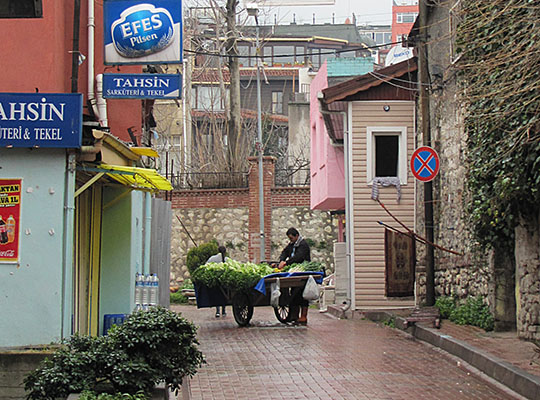
The early bird catches the salad
|
As in some countries the milkman, so in Istanbul the fruit and vegetable seller makes his morning rounds through the city streets. He will have already been to his suppliers in the wee hours to pick his wares; as they need to be fresh and he can not afford wastage, he must have a pretty good idea of his customers' requirements on a given day.
Cankurtaran, Istanbul |
| |
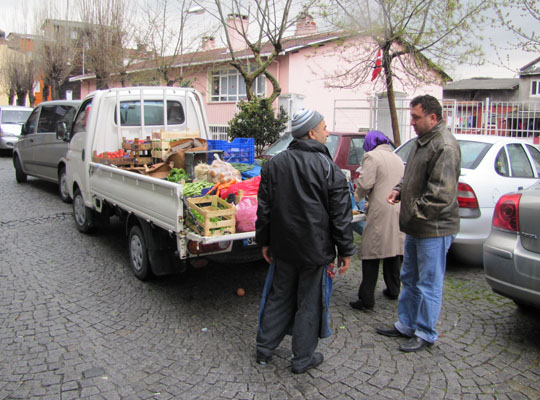
Wouldn't it be nice to get on with my neighbours?
|
Contact with customers in the neighbourhood is essential, and when the veg seller arrives in your street it's a good opportunity to dscuss the news, sport and local gossip.
Cankurtaran, Istanbul |
| |
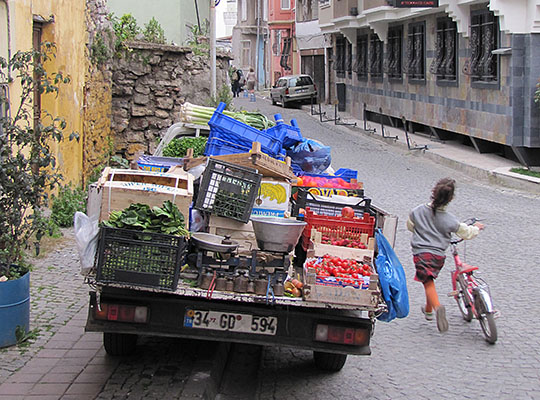
The competition never sleeps ... Well, hardly ever.
|
Some of Istanbul's older neighbourhoods, with their narrow streets in which children play and adults gossip and hang out their washing, still have a village character.
It is a mystery to outsiders if or how or the sellers of various wares arrange among themselves who sells in which area. Does each have to claim his own patch or is it a free-for-all?
In the countryside, delivery pickup trucks are equipped with megaphones to fanfare their arrival and announce their merchandise - anything from seasonal fruit, to meat, furniture and fancy goods. Their sales pitches can be quite creative and amusing.
As in many places in the world, the ancient, rickety-looking houses of Istanbul are often seen by their owners as a liability or just not profitable enough. Despite preservation laws, many old buildings are deliberately left to rot so that they must eventually be demolished. Modern apartment blocks and tourist hotels bring in more cash. In turn, the destruction of an area's character negates the reasons why people want to live or visit there in the first place.
In recent years Istanbul's authorities and private initiatives have attempted to save and restore many of these old buildings, and where they have been successful the results are impressive.
Cankurtaran, Istanbul |
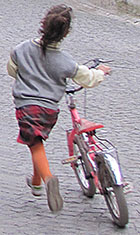 |
|
| |
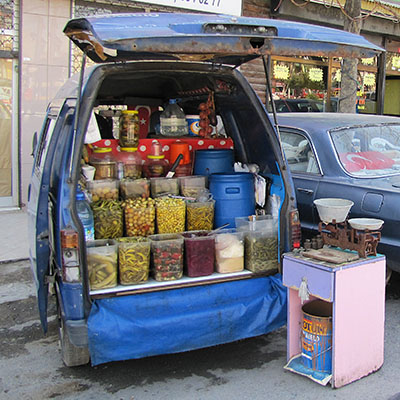
In a pickle
|
One alternative to patrolling the streets in search of
customers is just to park somewhere, open your tailgate
and go off for a cup of tea.
The olives, gurkins and peppers look very tempting, but
where's the establishment's owner? Not to worry, there's
bound to be another van just around the next corner.
Edirne Kapi, Istanbul |
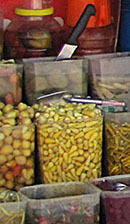 |
|
| |
| |
Hot chestnuts |
 |
|
| this photo has a mouseover effect |
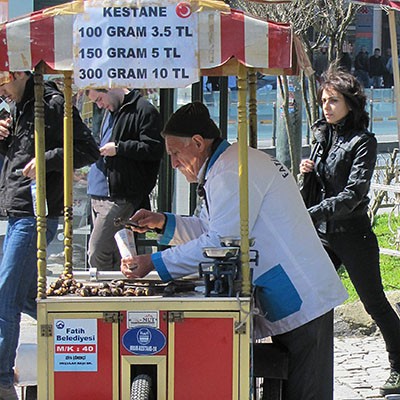
hot chestnuts
|
It may be surprising to find chestnuts and sweetcorn on sale in spring, but they seem to be popular fastfood snacks all year round in Istanbul. Licensed handcart vendors can be found all over the place, selling either chestnuts or sweetcorn or both. Take your pick.
Beyazit, Istanbul |
| |
| |
Maize in the maze |
 |
|
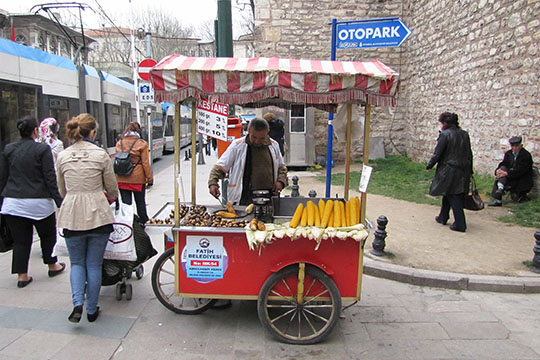
corn wall
|
Wandering through old Istanbul's labyrinth of streets, you are bound to get peckish. Luckily, there's always a sweetcorn or chestnut vendor within easy reach.
Being a typical northern European with a prediliction for boiled corn on the cob smothered in butter, I have never developed the taste for "roasted" maize. Leaving it on a hotplate just dries it out, and mostly it tastes burnt. Yet it appears to be a very popular street food in many countries. Each to his own taste.
Neither sweetcorn nor chestnuts are real appetite appeasers, and they are so dry that they are bound to make you thirsty. So why don't these guys sell drinks?
Gasp! Where's the next soft drink stand?
Sultanahmet, Istanbul |
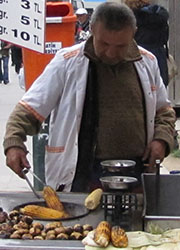 |
|
| |
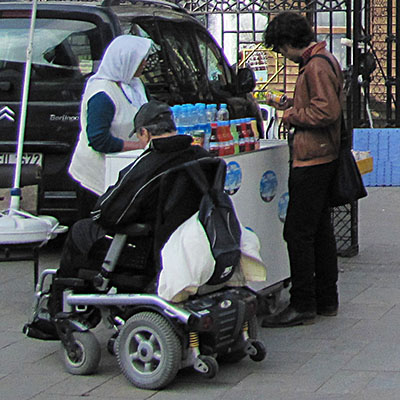
The next soft drink stand
There you go. Happy now?
Glug, glug, glug.
Gülhane Park, Istanbul |
| |
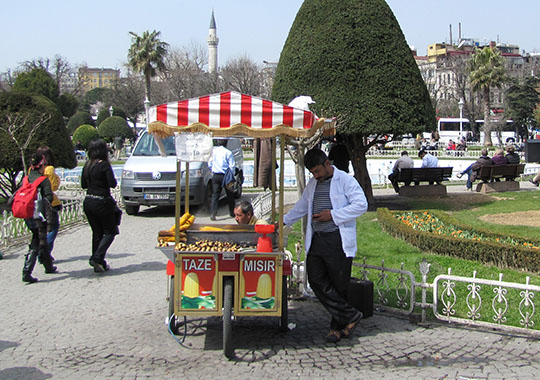
Location, location, location
|
This maize vendor has a great pitch between the Sultanahmet Camii (Blue Mosque) and Hagia Sofia. Thousands of tourists pass by every day, but since they seem to come in occasional huge waves, there's always a few minutes to check your SMSs.
Sultanahmet, Istanbul |
| |
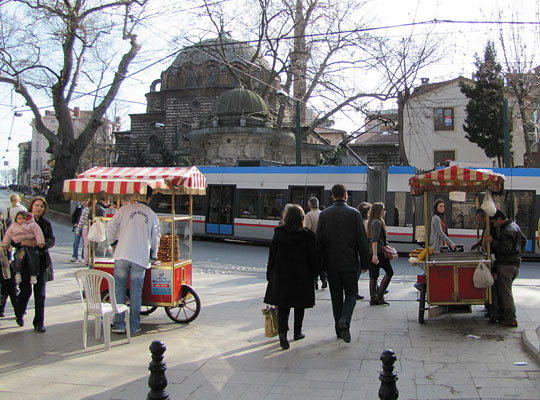
This town ain't big enough for the both of us
|
It looks like a turf war could break out between these two vendors on one of Istanbul's prime sites at an entrance to the Topkapi Palace grounds. The guy on the left has brought his chair with him, so he must be aiming to sit the competition out.
Zeynep Sultan Mosque, Sultanahmet, Istanbul |
| |
| |
Pretzel logic |
 |
|
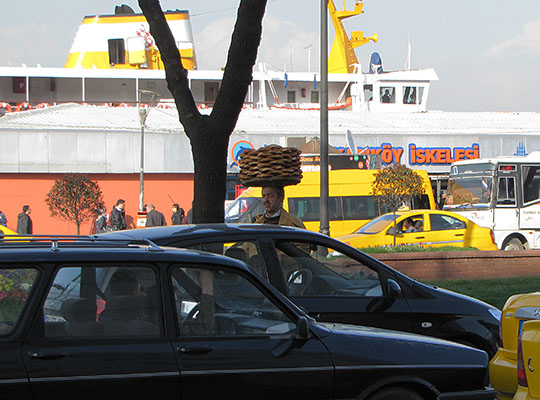
Dodging and weaving
|
Turkish Simitçi are bread rings covered with sesame seeds, similar to pretzels. Crispy on the outside, soft inside, and delicious. Try carrying a tray of them on your head, then you'll always know where to find them when you're hungry.
Once you've got that balancing act off to a tee, try walking through rush-hour traffic and engaging in conversation with the passing drivers. That should keep you on your toes.
Erminönü ferry port, Istanbul |
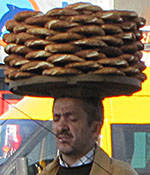 |
|
| |
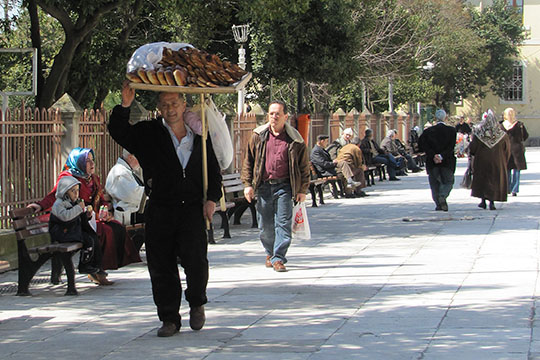
Using your loaf
|
Carrying bread products and all manner of other things on your head is all the rage in Istanbul. It may look very traditional and picturesque, but if I had to to do this job I would prefer something that causes less stress to the cranium and vertebrae.
If you can invent a more humane pretzel-carrying device perhaps the world will beat a path to your door.
Fatih, Istanbul |
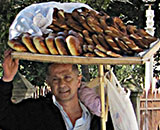 |
|
| |
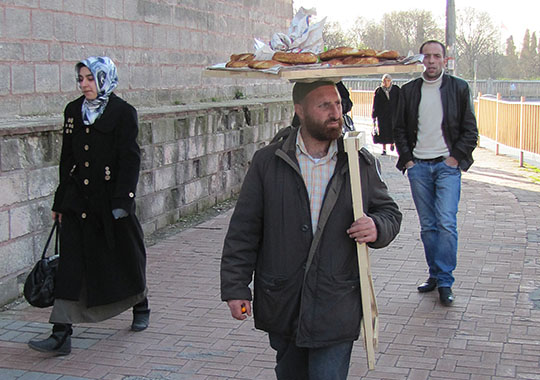
Thinking ahead
|
A master of cool, poise and balance, this chap has even brought a trestle for his tray.
Theodosian Walls near the Topkapi Gate, Istanbul |
| |
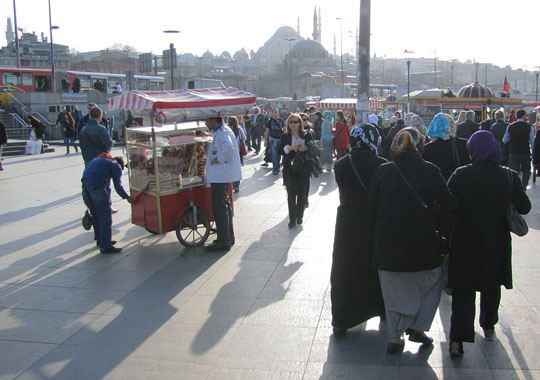
Afternoon delight
|
Istanbulers (Istanbulians? Istanbulees?) enjoy the spring sunshine outside the Yeni Camii (the New Mosque) on the banks of the Bosphorus.
Eminönü, Istanbul |
| |
| |
Busman's holiday |
 |
|
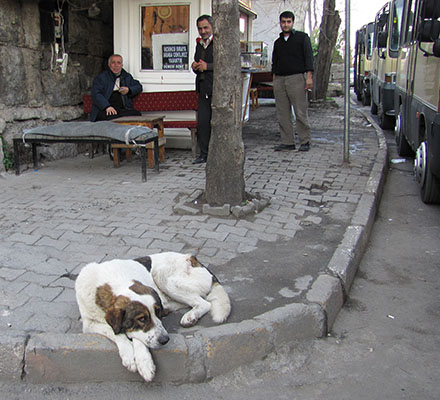
Let sulking dogs lie
|
A station for local buses, just inside the ancient city walls near the Topkapi Gate, where bus drivers take their break, complete with "buffet" or snacks kiosk. They told me that this dog was very smart and performed tricks. Unfortunately, he seemed to be suffering a creative block that day. They did try to coax him into action, but he didn't move a muscle.
Theodosian Walls, Istanbul |
| |
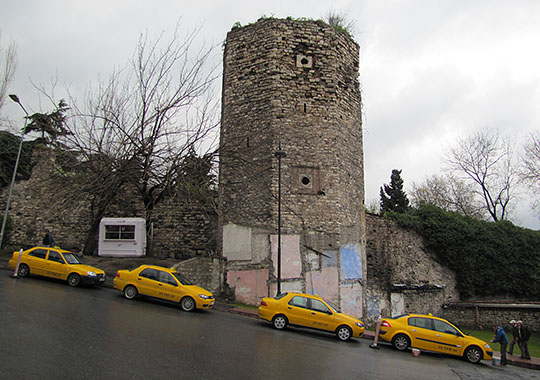
Newspaper taxis appear on the shore, waiting to take you away.
Taxi rank outside the walls of the Topkapi Palace.
Ishak Pasha Caddesi, Cankurtaran, Istanbul |
| |
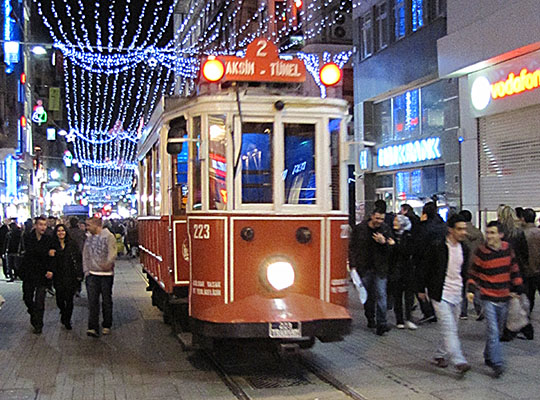
Make way for the "Nostaljik Tram"
|
Istikal Caddesi (Independence Avenue), between Taksim Square and Tünel, was known to foreign visitors during the 19th and early 20th century as Grande Rue de Péra * and was one of Istanbul's showpiece boulevards - the classic orient-meets-occident location. By the late 20th century it had become a grim, traffic-clogged street.
Now pedestrianized and given a facelift ("upmarket makeover"), it has become the main thouroughfare in Beyoglu's area of trendy cafes, bars and shops, including multinational chains, which attracts young middle class Turks and tourists.
Red trams of the "Nostaljik Tramvay" occasionally trundle through, clanging a bell to warn pedestrians as it shuttles the short distance between Taksim and Tünel, from where you can catch the funicular train up to the Galata Tower. Unfortunately, the tram driver's face is obscured by the reflection of a neon sign.
* Pera (Greek, Peran en Sykais, "the fig field on the other side") was the name of the Byzantine fortified citadel which is now the Beyoglu district. Emperor Justinian I (reigned 527–565 AD), had made it a city in its own right and named it Justinianopolis, but it appears to have been a flop, and was abandoned around the 7th century.
Galatasaray, Istanbul |
| |
| |
It's all in a day's work |
 |
|
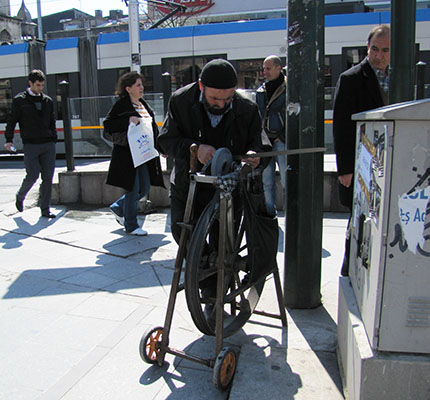
Life's a grind
|
Handworkers are becoming increasingly rare on Istanbul's streets, so much so that the sight of this pedal-powered knifegrinder even turns the heads of locals.
During Ottoman times, the Grand Bazaar complex included an arms bazaar selling swords, daggers and innumerable other nasty sharp things, which would have kept him busy. These days his skills are chiefly called upon to hone the long knives used to finely slice kebab meat.
Outside the Grand Bazaar, Beyazit, Istanbul |
| |
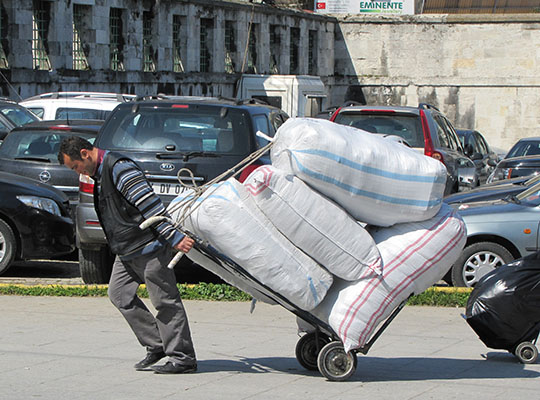
"Tote dat barge! Lift dat bale!"
|
The area around Istanbul's Grand Bazaar is full of men who heroically haul enormous loads around for a living. This porter is lucky, at least he has a trolley for his burden.
Outside the Grand Bazaar, Beyazit, Istanbul |
| |
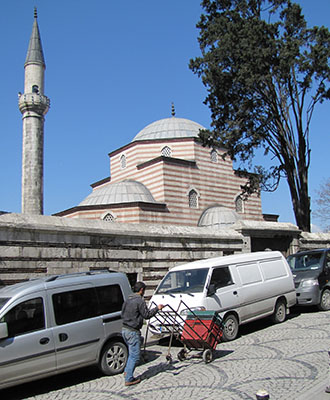
Going back for another load.
Şeyh Ebülvefa Mosque, Vefa, Istanbul |
| |
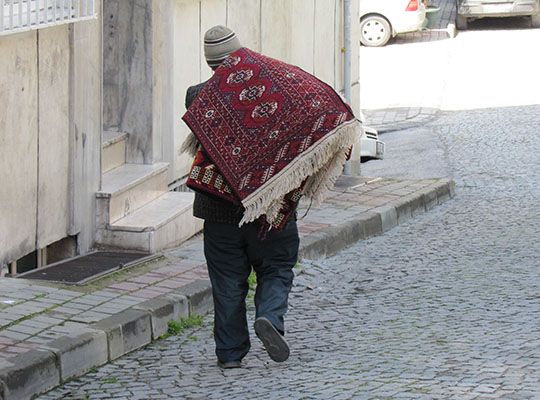
Pick up thy rug and walk.
Kumkapi, Istanbul |
| |
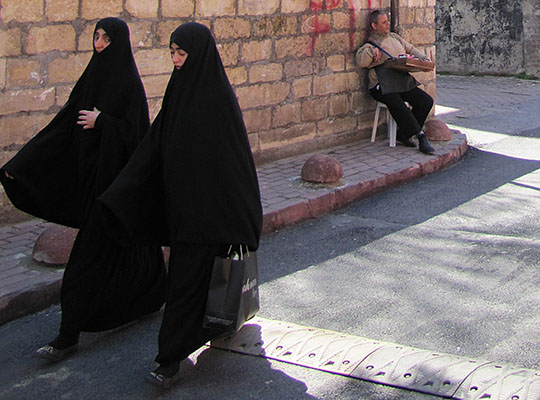 |
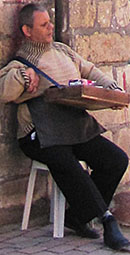 |
|
Blind sweet-seller, Fatih district
"She dropped a coin into the cup
of a blind man at the gate
And forgot about a simple twist of fate."
Bob Dylan |
|
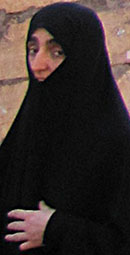 |
|
| |
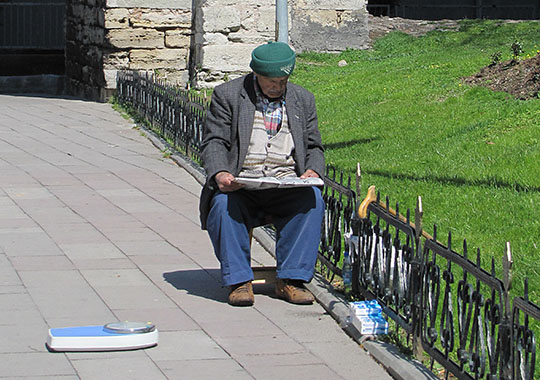
The weighting game
|
We all need to watch our weight these days, especially in a city so full of tempting snacks. This dapper gentleman has found his niche in a little-appreciated service industry branch. As an extra, he also offers paper hankies. It may seem like an easy job when the sun shines, but you try sitting around here waiting for clients when it rains and chill winds blow over the Bosphorus.
This is another prime pitch near the Aqueduct of Valens, built by the Roman Emperor Valens in the 4th century AD. The impressive structure was formerly 971 meteres long, 29 metres high at its highest point, and just a small part of the enormous network of aqueducts, canals and cisterns which provided the ancient city with fresh water.
Aqueduct of Valens, Fatih, Istanbul |
 |
|
| |
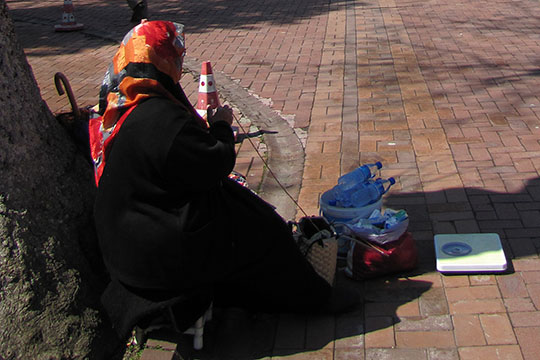
I don't want to weight in vain for your love...
|
This lady, knitting under a plain tree, is in the same trade as her colleague above. Maybe they even have their own special guild.
Imaret Kapisi, Fatih Camii, Fatih, Istanbul |
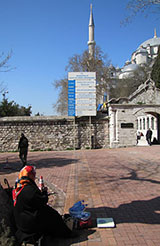 |
|
| |
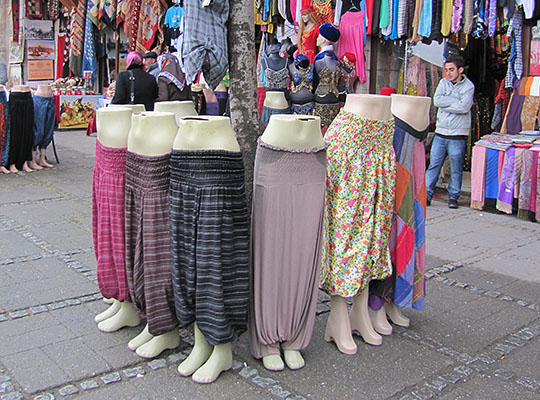
Topless in Istanbul
|
What is the collective term for tourists? A busload, a gaggle, a flash, a sunami? They pass by this shop on the way to the Hagia Sofia and Topkapi Palace (hence the harem pants) in huge groups. Then for a while all is quiet. This shop worker waits stoically for the next big wave.
Sultanahmet, Istanbul |
| |
| |
Cleaning up the town |
 |
|
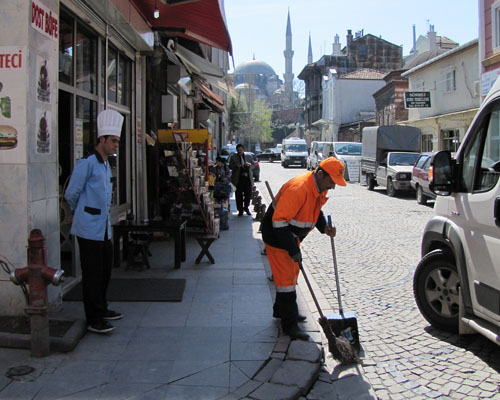
A clean sweep
|
An army of orange-clad workers toil around the clock to keep old Stamboul's streets clean and dispose of its garbage. The streets here are generally a lot better cared for than in many northern European cities, including Berlin where in some districts you will search in vain for a street sweeper.
Zeyrek, Istanbul |
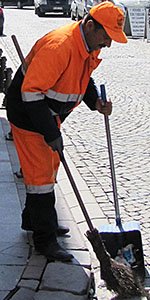 |
|
| |
 |
A major trash-collecting offensive
Aksaray, Istanbul |
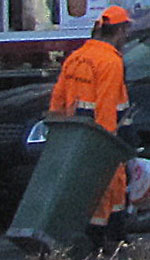 |
|
| |
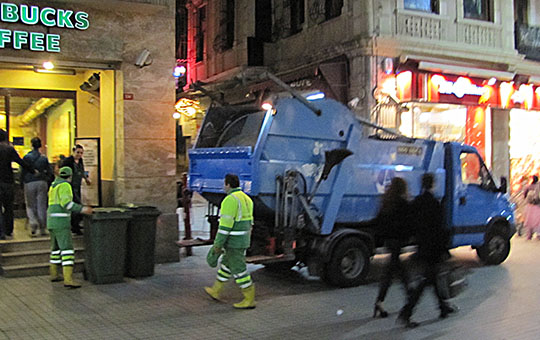
Over on the other side of the Golden Horn in the Beyoglu district,
the sanitary operatives are dressed in two-tone green.
Galatasaray, Istanbul |
| |
| |
A few moments pause ... |
 |
|
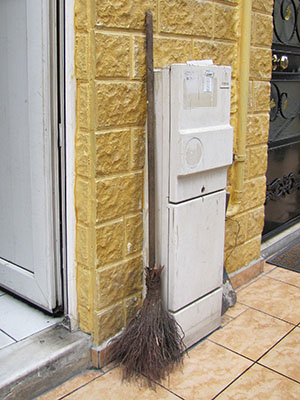
Down with the broom and on with
the tea kettle: time for a break.
Cankurtaran, Istanbul |
| |
| this photo has a mouseover effect |
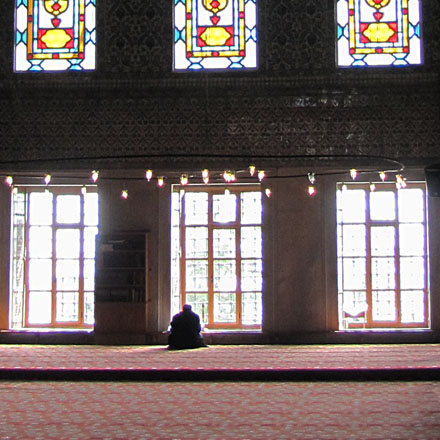
Contemplation
|
With an estimated 12.8 million inhabitants, Istanbul is the world's fifth largest city and one of the most densely populated. Mucho hustle-bustle. For many it is not easy to find place for a few moments peace. The numerous mosques - when not crowded with tourists - provide the chance of sanctuary and a little tranquility.
Sultanahmet Camii (the Blue Mosque), Istanbul |
| |
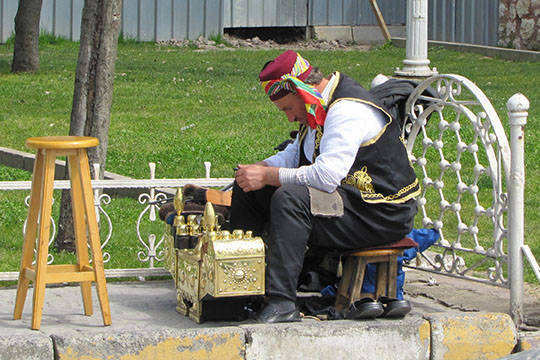
For a moment there...
|
I thought this shoe-shine man was also meditating, but he was just playing with his cell phone. The mobile phone has become the tamagotchi of the early 21st century: it's as if most of the people who have one are afraid that if they do not pay constant attention to it, it will die and their lives will be ruined.
Shoe polishing has to be one of the great dying arts, since everybody has taken to wearing trainers, sandals and footwear made from manmade materials.
Ouside the Blue Mosque, Sultanahmet, Istanbul |
| |
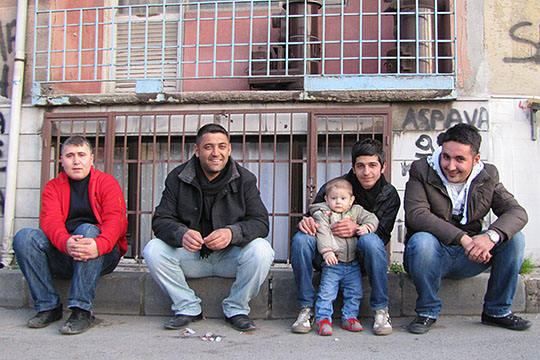
neighbours
|
Some people, myself included, hate having their photo taken. Some make a big fuss if they even see you with a camera. Surprisingly often though, people ask me if I will take a photo of them. I'm usually happy to be asked and pleased to oblige. But what's in it for them? Mostly they don't even give an address and will thus never even see the end result.
This happy group, in a poorer area near Istanbul's ancient walls, were just sitting on the street corner enjoying each others' company. Like all the people I have met in Istanbul, they were refreshingly friendly.
I hope that they some day find this photo, or that I may see them once more on Istanbul's streets. You never know.
Yedikule, Istanbul |
| |
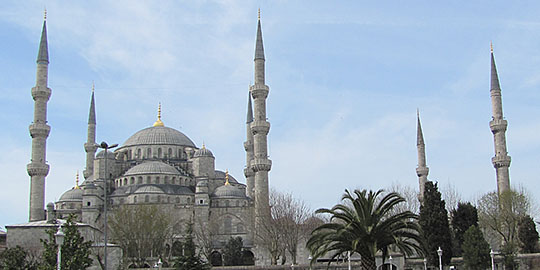
Sultanahmet Camii (the Blue Mosque)
|
Far too many visitors to Istanbul hurry from wonder to wonder, snapping whatever they encounter with cameras and mobile phones. I wonder if they ever actually see anything in their rush. What a waste. It's worth taking some time just to have a look.
"If we were allowed to take a glance at only one point of the earth,
this would be the one to choose."
Alphonse de Lamartine (1790-1869), French politician
and writer on his view of Constantinople in May 1833. [1]
Sultanahmet Camii, Istanbul |
| |

Raindance
OK, break over. On with the show ...
Sultanahmet, Istanbul |
| |
| |
Spending power |
 |
|
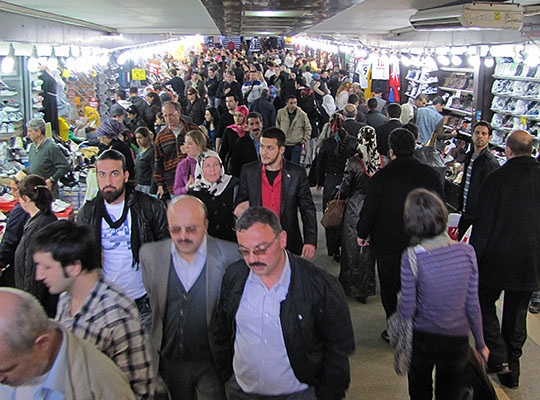
"Getting and spending we lay waste our powers"
From "The world is too much with us" by William Wordsworth 1802 [2]
|
In most of the world's cities every available space is used for advertising. In Istanbul any available space is used to set up a shop. Wherever you go in the city, somebody is trying to sell something. It's always been like that here.
This is a typical late afternoon crowd in the pedestrian subway under Ragip Gümüspala Caddesi between Yeni Camii (the New Mosque) and the Galata Bridge.
Eminönü, Istanbul |
| |
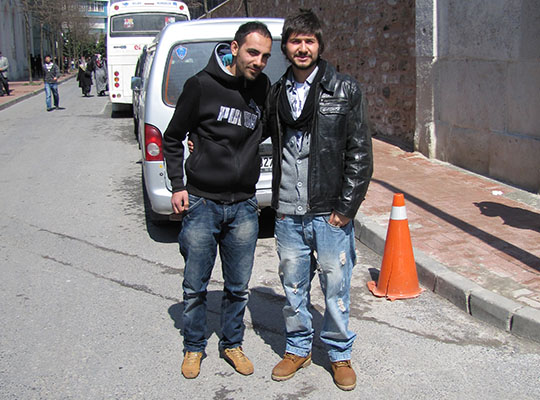
street meeting
|
Another two of the people who wanted their photo taken. Once again, spontaneously friendly guys who seemed to be just enjoying being alive. It must have been something in the fresh spring air.
Over the last two decades Istanbul's population has swelled considerably as more people move here from all over Turkey to seek their fortune or just find work. The birth rate also means that Turkey as a whole and Istanbul in particular are demographically very young.
The economy has also picked up considerably, which has lead to an overall improvement in the city's infrastructure and living conditions. There is still inflation and poverty, but generally more people seem to have more money to spend than 20 years ago.
Young people are especially motivated to earn and spend, and this is strongly reflected in the types of shops, bars and cafes around the city, particularly in the more modern area to the north of the golden horn around Taksim Square and Galata.
Istanbul University, Beyazit, Istanbul |
| |
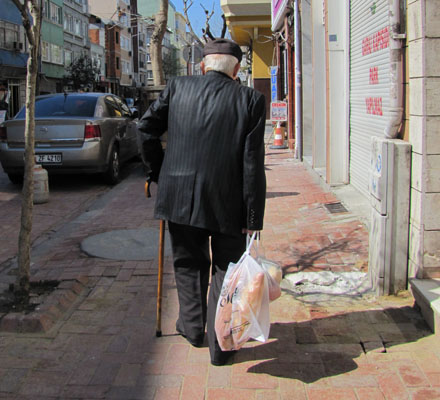
An old gent carries his groceries home
|
Dignity
In traditional communites families stick together. It may not always be ideal but it is the way it has always been: The old look after the young until the young are able to look after the old. It is the written and the unwritten law, underpinned by love, respect and an instinct for mutual protection. But the mass movement from agricultural to urban environments can turn the world on its head. Higher divorce rates, the gulf between generations and the pervasive sense of alienation in cities cause families to crumble.
So, who gives a damn about old people? Are they to be left to fend for themselves? Even in the so-called developed countries the hard fought for notion of pension rights is now under threat as the payouts fail to keep up with prices and the retirement age is pushed ever further beyond the discernable event horizon. How then are senior citizens in cities such as Istanbul supposed to survive when it's already tough when you are fit enough to work 12 hours a day?
Since the 1980s and the days of Reagan and Thatcher, inflation has been used as the primary economic lever for ratcheting up growth. This is about as useful as using a lump hammer as the only tool for any given task. Ever tried wallpapering with a lump hammer? Every time I go grocery shopping or pay a bill or read inflation statistics I wonder how anybody can swallow such nonsense. Today, Doctor Johnson may well have written "There are lies, damn lies, statistics and inflation statistics". Despite recurring catastrophes and warnings of limits to such growth (have we all already forgotten the Club of Rome report?), governments and corporations continue to prefer this idiotic model. Blinkered arguments that "it works some of the time" ignore not only the obvious evidence but also any possible alternatives.
Fatih, Istanbul |
| |
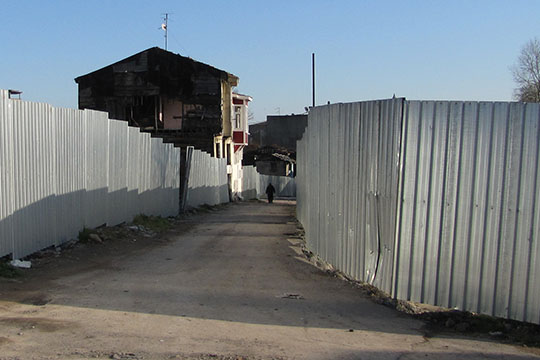
The former Romany district Sulukule demolished
|
Eradication
The scramble for "progress" and the prosperity of some has a high price for others.
These corrugated metal walls seal off the bulldozed wasteland which was once the ancient, colourful Gypsy district of Sulukule, from which many of its remaining 3,500 inhabitants have been forcibly evicted to make way for property development.
Some historians believe that Romany people arrived in Contantinople in the 11th century AD (as early as 1054). At first they lived in tents outside the Theodosian walls, but during the Ottoman period they began settling in houses in the Neslişah and Hatice Sultan areas which collectively became known as Sulukule (Water Tower).
The Roma have long used the land beneath the city walls for market gardening, and their produce, particularly the Romany lettuce, is popular all over Istanbul. Before its destruction, Sulukule had its own wells, fountains, bakeries and shops, and was in many ways a self-sufficient community with a strong mutual support ethic.
Roma families and settlements often have a single occupation-base, and while other Roma in Turkey specialize in trades such as basket-weaving, metal-working, horse-breeding or flower-selling, many of those in Sulukule became famous as entertainers: musicians, belly dancers, acrobats and illusionists. Sulukule cafes and entertainment houses here were popular amongst Istanbulers and tourists. However some also developed a dubious reputation, and in 1992 (following the collapse of the political left-wing, the rise of conservative-nationalist Islamism and consequent police raids) all were closed down by local authorities.
The closures led to unemployment and economic decline, which encouraged plans by conservative politicians and property speculators, who bought the land at low prices, to clear the area and build up-market condominiums in "Ottoman villa" style. Far too expensive for locals, the new development is set to become a yuppie enclave.
Plans were pushed ahead, enforced by new legislation and without consultation with the community, and the first mass demolitions began in early 2007. By the time of my last visit in April 2010 the destruction was almost complete, and on 6th May the mayor of the Fatih district (AKP, Justice and Development Party) laid the foundations for the first new building of the "Sulukule restoration project".
Sulukule's original inhabitants were offered alternative accomodation - upto 40 km outside Istanbul. The Roma themselves as well as many intellectuals and campaigners in Turkey and worldwide believe they are victims of discrimination and a deliberate plan to disperse and destroy their community. The politicians and police claim that Sulukule was a hotbed of child prostitution and criminality and in desperate need of restoration. If this is so, why did the local authorities make no investments or attempts to work with the community to restore the area physically, economically and morally over the last twenty years?
Was it all stick and no carrot? Did the AKP politicians condemn all the inhabitants of Sulukule and inflict a form of collective punishment on them? And why was Turkish Prime Minister and former Istanbul mayor Recep Tayyip Erdoğan (AKP) so committed "to clean the place up" like a Wild West sheriff? What was he afraid of exactly? And why do these Turkish citizens (who have lived here before Turkey existed) have no right to a say in their own future?
After surviving centuries of wars, earthquakes, fires, persecution and countless other calamities, Sulukule, an important part of a UNESCO World Heritage Site and of Istanbul's cultural history, has itself become merely history. Gone forever. This is end of one of Istanbul's oldest communities: along with the Greeks, Jews and Armenians, the Roma may be henceforth thinner on the ground in Istanbul.
Sulukule, Istanbul |
| |
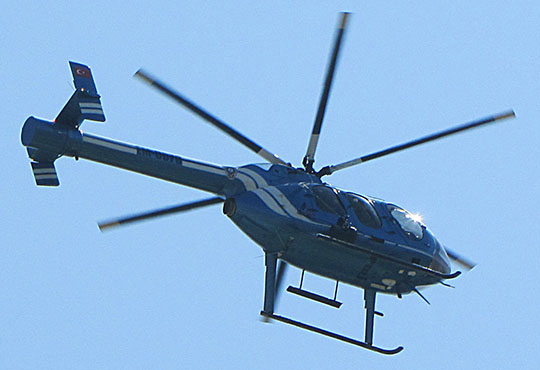
As above so below
Police helicopter over Sulukule, Istanbul |
| |
| |
Sport, Spass und Spannung
(sport, fun and excitement) |
 |
|
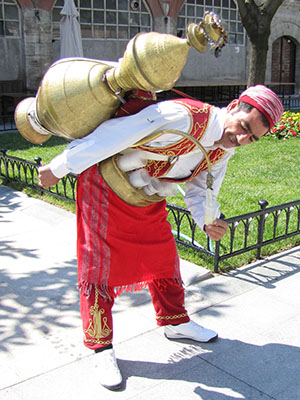
... and sherbert for all.
|
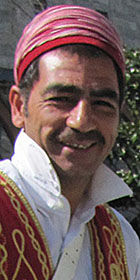 |
Mr Sherbert, with his folkloric costume, antique brass drinks dispenser and contagious smile, is a real entertainer. He will happily explain to you the refreshing benefits of his cool, sugary beverage, and you will be unable to refuse his charming invitation to drink a glass.
Sherbert is a traditional effervescent drink of Arabic or Persian origin (Arabic, sarba drink, from sariba to drink) made with fruit juice, sugar and water.
A year after writing this blog, I met Gengis again, by chance, on the streets of Istanbul (May 2011). This time he was "off duty", but was as happy, optimistic and entertaining as as ever. Greetings, Gengis, a pleasure to meet you.
Sülemaniye, Istanbul |
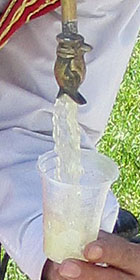 |
|
| |
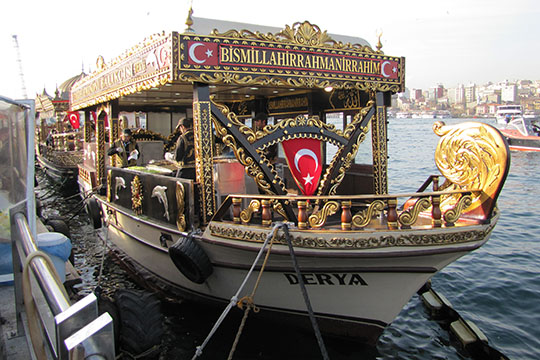
"Bismillah hir-Rahman nir-Rahim"
"In the name of God, the Merciful, the Compassionate"
|
The religious invocation emblazoned on this restaurant boat is an echo of the prayers of sailors since time immemorial: a call for protection for "all those in peril on the sea".
Despite the pious livery, these boats are not floating pulpits but are all about entertainment and hospitality, and more about marinades than mariners. A wide variety of vessels sell fish and other dishes along the banks of the Bosphorus or offer culinary cruises around what the Byzantine chronicler Procopius described as the garland of waters surrounding Istanbul. [3]
On the Bosphorus near Galata Bridge, Eminönü, Istanbul |
| |
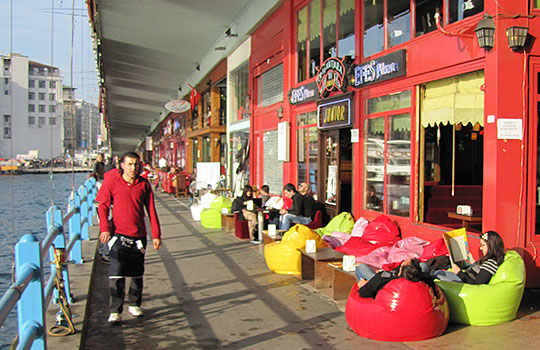
Catcher on the bridge
|
The Galata Bridge which spans the Golden Horn between ancient Eminönü and Galata is a double-decker affair. The upper deck carries traffic and pedestrians as well as providing an excellent perch for anglers (you can see some of the rods and lines in the left of the photo). The lower deck is dedicated to restaurants and bars. Nearly all the establishments used to be traditional restaurants, mostly specializing in a wide variety of fish. These days anything goes as a new generation of enterpreneurs aim at enticing locals and foreigners to spend a while gazing over the Bosphorus while sipping a glass of çai (tea), a beer or a cocktail.
Crossing the bridge can be like running the gauntlet, and the waiter (left in the red shirt and apron) is about to attempt to persuade me to take one of his plasic bean-bag seats and watch the impending sunset. I will be stopped by another four similar propositions before I get to the other side. I'd love to stop, I tell them, and maybe I'll come back tomorrow, but right now I've got to get up to the Galata Tower before the sun goes down.
Galata Bridge, Istanbul |
| |
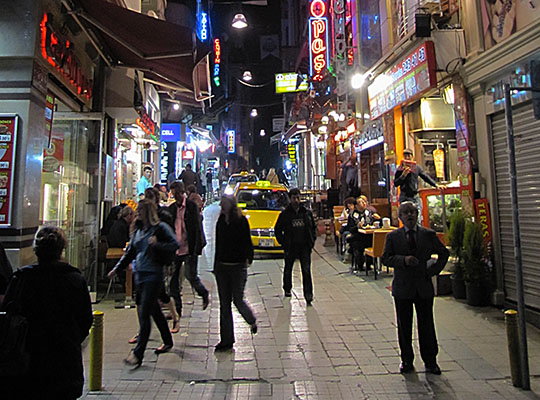
The lair of the Beast
|
There are no end of cafes, bars and restaurants in Istanbul. The two largest concentrations are around Sultanahmet in old Istanbul and in Galata just across the Golden Horn. Galata has really boomed in recent years as new places of entertainment spring up like autumn mushrooms and young people are drawn by the new sense of brash freedom. Over in Sultanahmet the religious and political atmosphere is more conservative and alchohol is not sold in the vicinity of mosques, which are highly concentrated on the peninsula.
Galata is not exactly a laissez-faire zone, but the central pedestrianized Istikal Caddesi and its surrounding streets, crammed with promises of pleasure, are pretty relaxed. This is where those with money to spend will meet up with friends for a night out.
Galatasaray, Istanbul |
| |
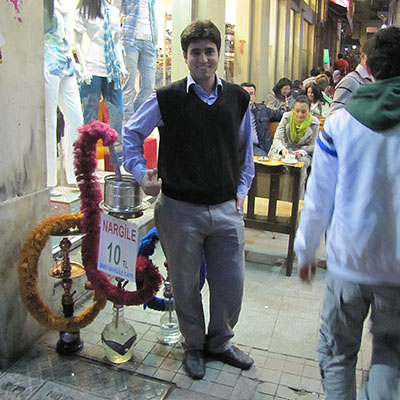
Hubble, bubble, no toils or troubles ...
|
The nargile (water pipe, hubble-bubble) has made a big comeback among young Turks, and in the face of smoking bans, so-called shisha bars are opening all over the place, including in Turkish communities in Europe. Puffing the pipe was once the pastime of old men as they played tavli (backgammon) or dominoes in their smoky men-only cafes. Now they have become the trendy accessories of the young in slick modern lounges.
As everywhere, American style is big. Clothing is casual or semi-casual, sporty, hoody, preppy, post-mod, pseudo-scruffy, punkesque or any possible combination of these. Neon-lit techno-pumping bars sit cheek-by-jowel with stylish Art Nouveau cafes, international chain outlets with paper cups and tradtitional Turkish tavernas.
Galatasaray, Istanbul |
| |
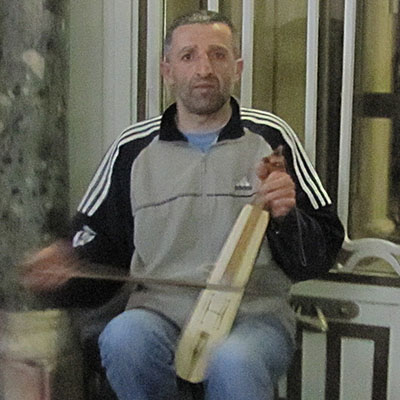
The power of music
|
Within a minute of this kemenche player taking his seat in a doorway he had attracted a crowd of Istanbul citizens of all ages. They evidently knew well the plaintive traditional melodies he played and some began dancing quite unselfconsciously. In the middle of this enormous city of 12.8 million, a small group of strangers enjoyed a few spontaneous moments of shared intimacy.
His instrument is a Karadeniz Kemençesi (Black Sea kemenche, from the Persian Kamancheh "small bow") three-stringed bowed lyre (or lute), also known as the "kementche of Laz" or Pontic kemenche, in Greek κεμεντζές (kementzes) or λύρα (lyra). The bow is called a doksar, in Greek δοξάρι (doxari, bow).
Developed and used over centuries by Greek and Turkish musicians of the Pontus region on the Black Sea coast, the Karadeniz Kemençesi is one of the main instruments of traditional Pontic music which remains popular all over Greece and Turkey.
Galatasaray, Istanbul |
| |
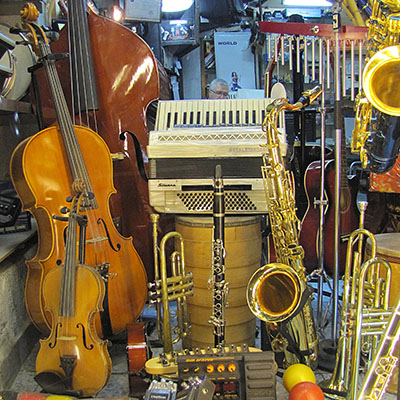
Music shop, Galip Dede Caddesi, Galata
|
Many ancient cities had quarters which specialized in particular trades, crafts and product types: metal, fabrics, leather, fruit and vegetables, spices, fish, meat... This kind of demarcation survived in European cities into the late twentieth century: think of Le Halles in Paris or Covent Garden, Billingsgate or Fleet Street in London. I remember a small area of Athens dedicated to the printing trade. Globalization and the rationalization of modern mass production and distribution methods put an end to many of these trade ghettos.
In Istanbul something of this specialization can still be seen, the most obvious example being the Spice Bazaar, and a few craftsmen still bash metal or make jewellery and clothing by hand in the narrow streets behind the Grand Bazaar. Just below the Galata Tower, Galip Dede Caddesi is a long, narrow, cobble-stoned street lined with music shops where you can buy an old Turkish baglama (lute) or plastic marimbas. As you would expect, guitars are big sellers.
Galata, Istanbul |
| |
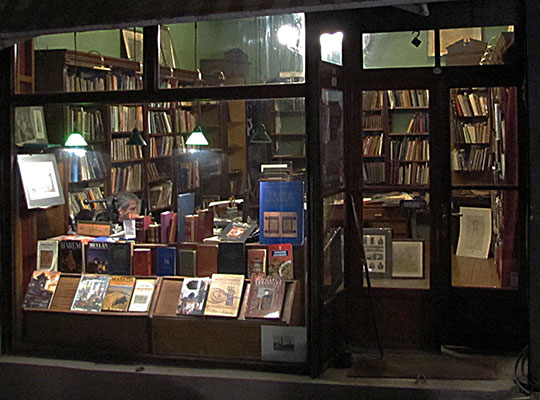
Bookshop, Galip Dede Caddesi, Galata
|
Where have all the bookshops gone? Into the world wide web every one. Well, almost. The convenience of ordering just about any book you desire online and have it delivered within a few days is an overwhelming temptation for any bibliophile. Amazon be praised!
But there's nothing like browsing a bookstore, handling those wonderful objects and getting a whiff of fresh printing ink in your nose; older books contain their own musty mysteries. I had to banish myself from bookshops for quite a while as I am pathologically incapable of visiting one without buying something (ditto record stores). Lucky for my bank balance that all but one of the bookshops in the area of Berlin where I live have long-since closed down.
Turks are rightly proud of their long literary tradition which goes back at least 1,500 years. Older Turkish books (pre 1930s) are now unreadable for most people as they were written in the Perso-Arabic script. Gems of Ottoman poetry and wisdom have to be transliterated into the modern Turkish alphabet, based on the Roman alphabet, which was introduced by Atatürk in 1928. An increasing number of people are also taking an interest in their country's history and culture which has created a market for large colourful books, many of the coffee table variety. Modern authors such as Orhan Pamuk (winner of the 2006 Nobel Prize in Literature) can still make international headlines as well causing considerable political controversy.
Galata, Istanbul |
| |
| |
Open all hours |
 |
|
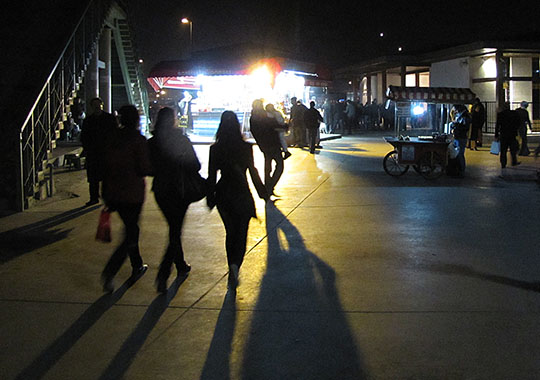
Going on the town
|
The sun's gone down, and it's time "to shine your city shoes", get out there and enjoy Istanbul's nightlife. For others it's just the start of another night shift on the city's streets.
Erminönü ferry port, Istanbul |
| |
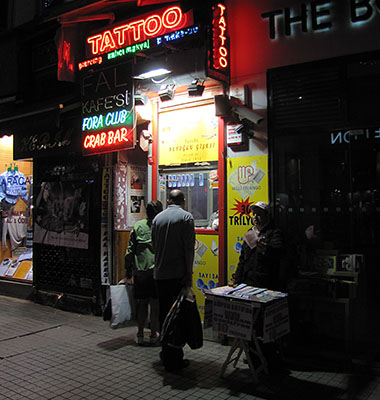
Lottery ticket seller, Istikal Caddesi
|
He holds in his hand pink slips of paper, each one the promise of all-too-imaginable riches and all-too-unattainable dreams. The "Süper Loto'da" this evening has a jackpot of "10 trilyon". Sadly, as we all know, the chances of winning such lotteries are slimmer than being run over by a chestnut vendor's cart. But this does not stop people buying them in their millions; a chance, no matter how slim, is still a chance.
Beyoglu, Istanbul |
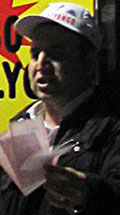 |
|
| |
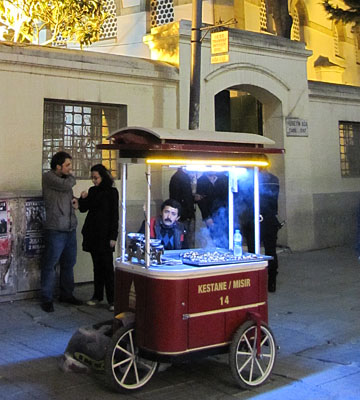
Chestnut seller outside the Huseyn Aga Mosque (built 1597) on Istikal Caddesi.
|
The vending carts in Beyoglu are a bit more stylish and streamlined than the boxy ones on the other side of the Golden Horn, but the wheel design is just as naff.
Beyoglu, Istanbul |
| |
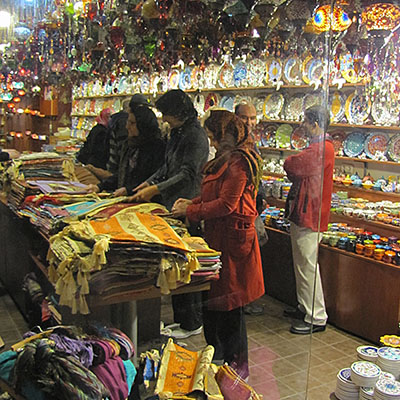
Major browsing activity
|
The gaudy colours of glass lamps, ceramics, rugs and other paraphenalia bearing traditional Turkish motifs lure locals and tourists alike into shops such as these which stay open late into the night. Resistance is futile. I bought some plates as gifts for friends who will probably think I must have lost the plot. They could be right.
Galatasaray, Istanbul |
| |
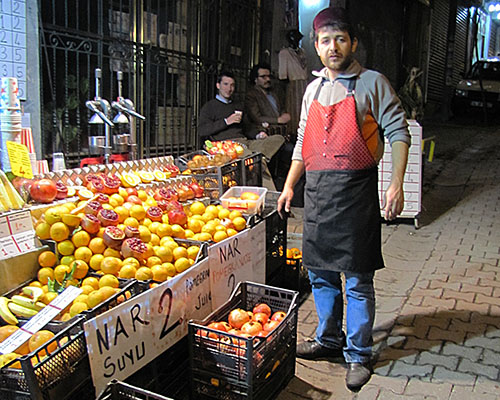
I don't want to do it without my fez on
|
One of the many shops and kiosks around Istanbul where they will turn oranges, bananas and pomegranates into juice - in a trice (or more likely a blender). There are usually stools or chairs to sit on while you get your vitamin top-up. Some places also do milkshakes. The banana milkshakes are particularly de-lic-ious.
Galip Dede Caddesi, Galata, Istanbul |
| |
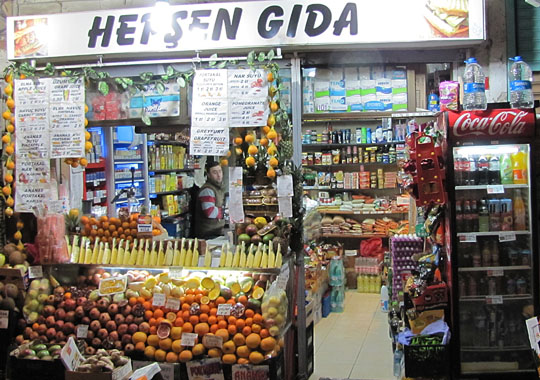
The corner grocery store is still alive, kicking and open all hours to provide
customers with some of life's essentials and a few luxuries.
Galata, Istanbul |
| |
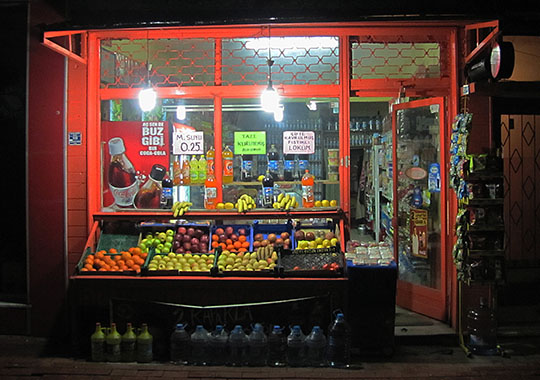
Some of these stores never seem to close. Usually family members take shifts
to cater for those who run out of lentils or fizzy drinks at midnight.
Kumkapi, Istanbul |
| |
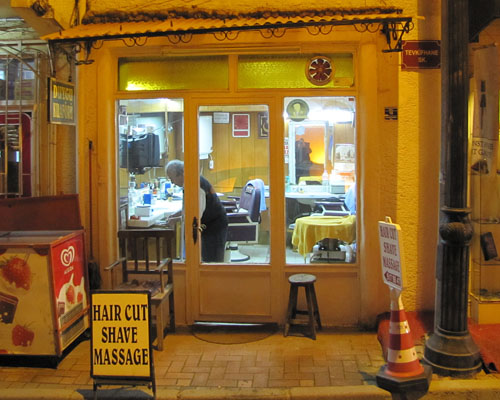
This barber, for one, is calling it a day and is cashing up for the evening.
Will he be going straight home, or will he stop off for a nargile and a
game of tavli (or two...) with friends?
Sultanahmet, Istanbul |
| |
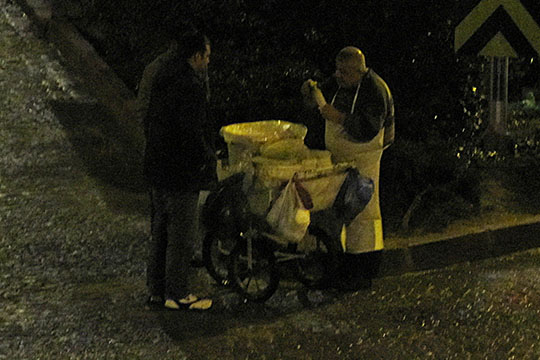
Late night hunger
A nighthawk stops off to buy a snack from a night hawker.
Sultanahmet, Istanbul |
| |
| |
The end of the day |
 |
|
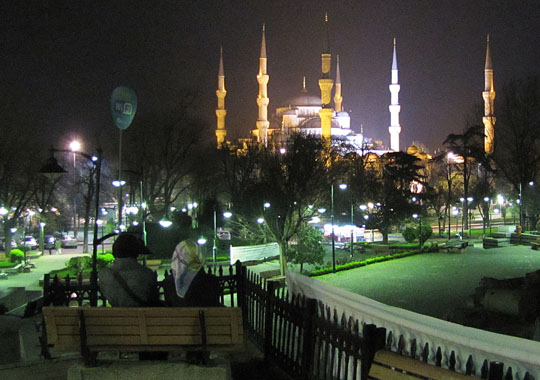
Evening idyll
|
Well, that was a long day, wasn't it? And we certainly got around.
What shall we do tomorrow?
Two young headscarfed Turkish women enjoy the view of the floodlit Blue Mosque.
Sultanahmet, Istanbul |
|
| |

Blue Mosque
minaret |
| |
| |
| |
| |
Istanbul, the land of cats
Since writing this blog I have visited Istanbul again (see Istanbul essentials - Part 3: Istanbul wedding dance).
There I had the pleasure of meeting Dr. Henrik Hofmann, a vet from Butzbach in Germany, who was visiting the city with his family. Henrik is a man with ideals and an active interest in animal welfare. He runs a blog in German called Es Spricht (It speaks) about his works and interests. The 30 April 2011 edition, "Istanbul ist Katzenland" (Istanbul is the land of cats) www.es-spricht.de/katzen-in-istanbul/, features several of his wonderful photos of cats in Istanbul to accompany his article about the plight of the enormous number of stray animals in the city.
In the blog he also calls for information about animal protection organizations in Turkey.
If you can help him, please send a message through his blogsite.
David John, May 2011. |
|
| |
|
| |
| |
Istanbul: Some background information |
 |
|
| Byzantium, Constantinople, Istanbul |
The area of Istanbul was inhabited as far back as 9,000 years ago during the Neolithic era. Between the 13th and 11th centuries BC Thracian tribes established two settlements, Lygos and Semistra, near the site of the present Topkapi Palace. The Thracians were driven out around 660 BC by Greeks from Megara under King Byzas who founded Byzantium (Greek Byzantion). The city was strategically important in controlling the Bosphorus as a route between the Mediterranean and Black Seas and a crossing point between Europe and Asia.
In 73 AD Byzantium became part of the Roman Empire, and when Constantine I became emperor in 324 AD he replanned it as the new eastern imperial capital Nea Roma (New Rome). However it quickly became known as Constantinople (Konstantinoupolis, the city of Constantine), a name which stuck right into the 20th century. In 330 AD the city was proclaimed capital of what was to become known as the Eastern Roman Empire or Byzantine Empire. It also became the powerful centre of the Greek Orthodox church and medieval Greek culture.
Byzantine power began to decline by the beginning of the 13th century, and in 1204 Constantinople was captured by Roman Catholic troops of the Fourth Crusade, after which it became part of the Latin Empire. The enfeebled Byzantine Empire managed to reestablish itself in 1261 but the Ottoman Turks were soon to set themselves the task of conquering it.
Sultan Mehmed II "the Conqueror" took Constantinople on 29 May 1453, and thereafter it became a predominantly Muslim city.
The name Istanbul (or Stamboul) had been used for centuries, but only became the official name in 1930 following the establishment of the Turkish Republic by Atatürk and his Young Turk revolution. "Istanbul" derives from the Greek στην Πόλη (stin poli: in or to the City). |
|
| |
| Sultanahmet |
The name Sultanahmet is often used to describe the entire old city of Istanbul within the city walls and the peninsula on which stands. But strictly speaking, Sultanahmet is the area around the Sultanahmet Camii, also known as the Blue Mosque, which was built for Sultan Ahmet (ruled 1603-1617) by architect Mehmed Aga "Sedefkar" (died 1622) who had been an apprentice of Sinan.
Before the establishement of the modern Greater Istanbul Metropoltan Area, with its 39 districts encompassing the 5,343 square kilometres of land on the European and Asian sides of the Bosphorus Strait, the successive names Byzantium, Constantinople and Istanbul referred to the city on the peninsula itself. This also became known as Eminönü, which now just refers to the tip of the peninsula around the the Yeni Camii (New Mosque) near the Galata Bridge. Officially, the old city is now the metropolitan district of Fatih (confusingly also the name of a neighbourhood in the west of the old city, famous for its nationalistic Muslim conservatism).
The other three important modern administrative districts of the Istanbul, as far as most visitors are concerned, are Beyoğlu on the other side of the Golden Horn, which includes the areas of Galata and Taksim; and on the Asian side of the Bosphorus Strait Üsküdar (the ancient Greek Chrysopolis and medieval Scutari) and Kadıköy (the ancient Chalcedon).
As well as the names of Istanbul's official districts, locals also refer to places and neighbourhoods in terms of their proximity to local landmarks such as mosques (e.g. Sülemaniye), squares (e.g. Beyazit) and ancient city gates (kapi, e.g. Topkapi, Yenikapi). In addition, train, metro and tram stations provide orientation points around the city (or confuse you even further). |
|
|
| |
| |
Notes, references and links |
 |
|
1. " ... a glance at only one point of the earth ... "
Alphonse Marie Louis de Prat de Lamartine (1790-1869), French politician, writer and poet, Souvenirs, impressions, pensées, et paysages pendant un voyage en Orient, 1832-1833 (often referred to simply as Voyage en Orient). Paris, 1835.
Published in English in several editions and formats (without crediting the translator; did Lamartine translate it himself?), including:
A pilgrimage to the Holy Land; comprising recollections, sketches, and reflections, made during a tour in the East in 1832-1833. Carey, Lea and Blanchard, Philadelphia, 1838.
Travels in the East, including a journey in the Holy Land. William & Robert Chambers, Edinburgh, 1850 (2 volumes).
The following is often published and slavishly copied as a quotation:
"If one had but a single glance to give the world, one should gaze on Constantinople." I have never seen the source of this cited, and have yet to find it myself. I suspect it is a misquote, or rather a mangling to make a more appetizing soundbite.
Here are two excerpts of Lamartine's recollections
of his visit to Constantinople in May 1833:
|
|
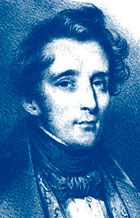
Alphonse de Lamartine
by an unknown
artist, 1836 |
|
May 20th 1833, arrival by ship at Constaninople on the Sea of Marmara side (Yenikapi ?)
"At five o'clock I was standing on the deck, when the captain ordered a boat to be lowered. I descended with him, and we made for the mouth of the Bosphorus, coasting the walls of Constantinople, which are washed by the sea. After half an hour's navigation through innumerable vessels at anchor, we touched at the walls of the seraglio, which continue those of the city, and form, at the extremity of the hill on which Stamboul stands, the angle separating the Sea of Marmara from the channel of the Bosphoms; and the Golden Horn, or great interior harbour of Constantinople.
Here it is that God and man, nature and art, have placed, or created in concert, the most extraordinary landscape that human eyes can contemplate upon earth. I uttered an involuntary exclamation, and obliterated for ever from the tablets of my mind the Bay of Naples with all its enchantments. To compare anything with such a concentration of loveliness and magnificence is to wrong creation."
May 25th 1833, the view from Pera (Galata)
"The finest point from which Constantinople can be viewed is just above our place of abode. It is from a belvedere built by M. Truqui [the Sardinian Consul-General] on the terraced roof of his house. This belvedere commands the entire group of hills of Pera, Galata, and the little hillocks which surround the port on the fresh-water side. It is the eagle's flight over Constantinople and the sea. Europe, Asia, the entrance of the Bosphorus, and the sea of Marmara, are all under the eye at once. The city lies at the feet of the spectator. If we were allowed to take a glance at only one point of the earth, this would be the one to choose.
Whenever I ascend to the belvedere to enjoy this view, (and I do so several times a day, and invariably every evening), I cannot conceive how, of the many travellers who have visited Constantinople, so few have felt the beauty which it presents to my eye and to my mind. Why has no one described it? Is it because words have neither space, horizon, nor colours, and that painting is the only language of the eye?
But painting itself has never portrayed all that is here. The pictures I have seen are merely detached scenes, consisting of dead lines and colours without life: none convey any idea of the gradations of tints, varying with every change of the atmosphere and every passing hour. The harmonious whole and the colossal grandeur of these lines; the movements and intertwinings of the different horizons; the moving sails scattered over the three seas; the murmur of the busy population on the shores; the reports of the cannon on board the vessels; the flags waving from the mast-heads; the floating caiques; the vaporous reflection of domes, mosques, steeples, and minarets in the sea."
back to photo |
|
|
|
2. "The world ts too much with us"
From a sonnet by the English Romantic poet William Wordsworth (1770-1850), written about 1802, first published in Poems, In Two Volumes, 1807.
The world is too much with us; late and soon,
Getting and spending, we lay waste our powers;
Little we see in Nature that is ours;
We have given our hearts away, a sordid boon!
This Sea that bares her bosom to the moon,
The winds that will be howling at all hours,
And are up-gathered now like sleeping flowers,
For this, for everything, we are out of tune;
It moves us not. - Great God! I'd rather be
A Pagan suckled in a creed outworn;
So might I, standing on this pleasant lea,
Have glimpses that would make me less forlorn;
Have sight of Proteus rising from the sea;
Or hear old Triton blow his wreathed horn.
back to photo |
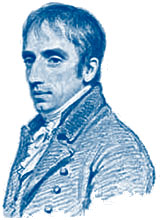
William Wordsworth
by Henry Eldridge, 1804 |
| |
|
3. "Thus the sea forms a garland about the city."
Buildings (Greek: Περί Κτισμάτων, Latin: De Aedificiis, On Buildings) Book 1, Chapter 5. A treatise on the public works of Emperor Justinian by the Byzantine historian Procopius of Caesarea (500 - circa 565 AD), written around 560 AD.
"2 Besides the city's other blessings the sea is set most beautifully all about it, forming curving bays, contracting into narrow straits, and spreading into a great open sea; and thus it makes the city exceptionally beautiful, and offers the quiet shelter of harbours to navigators, thereby abundantly providing the city with the necessities of life and making it rich in all useful things.
3 For in reality there are two seas embracing it, the Aegean on the one side and the sea called the Euxine on the other; these unite with each other to the east of the city, and rushing together as they mingle their waves, and pushing back the solid land by this invasion, they beautify the city as they surround it.
4 So it is encircled by three straits which open into one another, so disposed that they both adorn and serve the city, all of them most delightful for sailing, each a pleasurable sight for the eye, and very commodious for anchorage.
5 And the middle one of them, coming down from the Euxine Sea, flows straight toward the city, as though to beautify it, and on either side of it the two continents are placed.
6 And it is pressed in by their banks, so that it ripples and seems to plume itself because it approaches the city mounted upon both Asia and Europe.
7 One would imagine that he was looking upon a river moving toward him with gentle current. And the strait which lies on the left of this is confined by its shores on either side for a very great distance, displaying the woods and the lovely meadows and all the other details of the opposite shore which lie open to view from the city.
8 Then from that point it broadens as it is thrust away from the city toward the south, and carries the coast of Asia very far from the city.
9 Yet the wash of the sea continues to envelop the city up to its western boundary. The third strait, which branches off from the first toward the right, commencing at Sycae, as it is called, extends for a very great distance along the side of the city which faces the north, and terminates in the bay which forms its end.
10 Thus the sea forms a garland about the city; the remainder of the city's boundary is formed by the land which lies between the two arms of the sea, and is of sufficient size to bind together there the crown of waters.
11 This bay is always calm, being so fashioned by nature that it is never roiled, just as if limits were set there for the turbulent waters and all billows were excluded from that area so as to do honour to the city.
12 And in winter, even should violent winds chance to fall upon the open spaces of the sea and upon the strait, as soon as ships reach the entrance to the bay, they proceed for the rest of the way without a pilot and are anchored without precautions.
13 For the circuit of the bay extends to a distance of more than forty stades, and furnishes anchorage throughout its whole extent; so that when a ship anchors there the stern rides upon the sea while the prow rests upon the land, as if the two elements contended with each other to see which of them would be able to render the greater service to the city."
See: penelope.uchicago.edu/Thayer/E/Roman/Texts/Procopius/Buildings/1B*.html
At Bill Thayer's LacusCurtius website, University of Chicago.
back to photo |
|
|
| |

Ottoman ceramic tiles in the Topkapi Palace, Istanbul |
Photos and text: © David John 2010
The Cheshire Cat Blog at My Favourite Planet Blogs
We welcome comments and feedback on these articles
and all other blogs on My Favourite Planet.
Please get in contact.
The photos on this page are copyright protected.
Please do not use them without permission.
If you wish to use any of the photos for your website,
blog, project or publication, please get in contact.
Higher resolution versions are available on request. |
 |
|
 |
Visit the My Favourite Planet Group on Facebook.
Join the group, write a message or comment,
post photos and videos, start a discussion... |
|
Views of blog authors do not necessarily reflect those of the publishers
or anyone else at, on or in the vicinity of My Favourite Planet. |
 |
| |
|
|
|